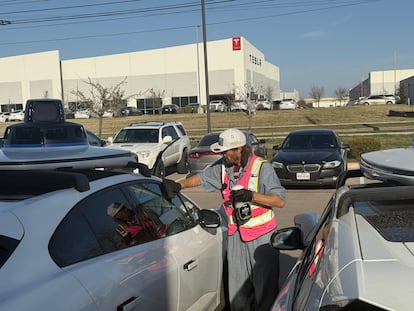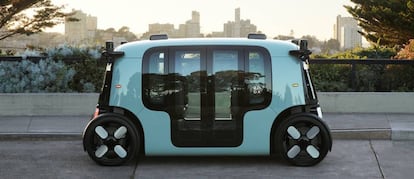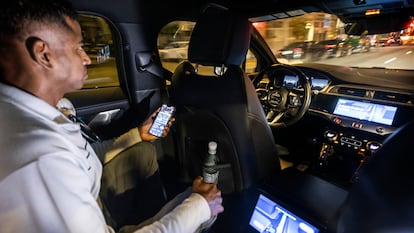The war over the robotaxi’s future escalates in Austin, the Silicon Valley of Texas
The alliance between Uber and Waymo in the city, where Musk has plans for Tesla in June, opens new avenues for expansion in the self-driving car sector


The garage storing Waymo’s driverless taxis — which are used in Austin exclusively by Uber — stands in front of one of Tesla’s buildings in the metropolitan area of the Texan capital. This is the city where Elon Musk took Tesla during the pandemic, feeling fed up, he said, with California’s “woke” vibe. It is as if the front line of the war for the future of autonomous driving has been moved to this spot with little to separate the two industrial buildings.
On one side of the street are Uber and Waymo, which in early March launched a collaboration in a city known as the Silicon Valley of Texas. Waymo, owned by Alphabet (Google), was already supplying Austin, San Francisco, Los Angeles and Phoenix with driverless taxis; Now, not only will Waymo expand into Atlanta, they will provide their service only through the Uber app, which makes “dozens” of cars available to users, operating in an area of 36 square miles as part of a service that continues to include vehicles with drivers.
On the other side of the street is Musk, who has just been awarded the first permit to operate in California. The billionaire has promised that Tesla will introduce its own service here in June, although hardly anyone in a sector that is experiencing a slow-motion boom is convinced this will actually happen. This is not so much because the richest man in the world is busy being Donald Trump’s best buddy and DOGE chief — turning Tesla into a target for vandalism and protest and causing the company to lose 40% of its value on the stock market — but because Musk has been breaking promises about Tesla’s imminent leap into self-driving for a decade. Last October for example, when Tesla presented its Cybercab prototype with its futuristic look, and no steering wheel or pedals, the markets showed their dissatisfaction with a punishing 8.7% drop in value.
A group of senior Uber executives were recently in Austin to tell the press the details of the new pact between Waymo and Uber. The idea is to sing the praises of Austin as the ideal laboratory to test the future of transportation: “electric, shared and autonomous in a world with fewer and fewer cars.” The fact that the chosen setting is in Texas — a state proud of its oil wells — speaks of how much has changed in a city whose population is growing steadily, thanks in large part to the employees of tech companies attracted by a favorable tax system.
“A market with so many people excited about new technology is a great starting point,” says Noah Zych, Uber’s global manager of Autonomous Mobility and Delivery. The loose regulations, a climate suited to a type of car that prefers the heat to the cold, and the clean, wide layout of the downtown area explain why Austin is prized: besides Waymo, ADMT (Volkswagen) and Zoox (Amazon) are undertaking testing here, as well as a local company, AVRide, which has already teamed up with Uber to deliver food to homes with friendly robots in the shape of a beach cooler.

In its agreement with Waymo, Uber is in charge of putting cars full of sensors, cameras, radars and lights at the service of its users, who might not feel the urge to try them out if they had to download yet another app. To opt for a driverless vehicle, users have to indicate as much on the app’s preferences, and the algorithm will decide whether to assign them a car with or without a driver.
Uber is also responsible for maintaining the fleet, a task that has been contracted out to a Spanish company called Avomo, which also organizes prices and flows.
The workers at Avomo are the ones who manage when the robotaxis should be in which part of the city and when it’s best for them to be picked up at night — to save them from cruising along Sixth Street, popularly known as “Dirty Six,” when it is teeming with drunk people. A warning to those tempted to vandalize self-driving vehicles or sit in the driver’s seat: robotaxis have multiple cameras inside and outside the vehicle. They are also fitted with microphones, although an audio message assures the user that their conversations will not be recorded.
Waymo, for its part, is responsible for equipping the Jaguar cars with fifth-generation technology which its managers are extremely secretive about. Waymo is also in charge of repairs, providing roadside assistance and carrying out safety checks. The Alphabet-owned company, which has grown in a few months from 10,000 to 200,000 weekly trips, has become more of an industry leader after General Motors’ decision in December to stop funding Cruise, its venture into the autonomous driving business. This pullout happened months after Cruise lost its license in California following a hit-and-run involving a female pedestrian in San Francisco.
Ghost driver
Sachin Kansal, chief product officer and head of mobility and delivery at Uber, demonstrated how to order a Waymo on his company’s app mid-March. The robotaxi arrived shortly, with his initials, SK, flashing on the roof. Once inside, Kansal explained from the back seat that the two companies that were embroiled in a court battle over industrial espionage in 2018, have joined forces because Uber sold its self-drive business in 2020, two years after a woman died in Arizona after being hit by one of its cars. That led to Uber switching to a “platform approach,” which has led it to develop agreements with 14 autonomous driving tech partners.

The price of Sachin Kansal’s taxi was the same as if the Uber had arrived with someone behind the wheel. Before the demo ride, Andrew MacDonald, Uber’s senior vice president for Mobility and Business Operations, pointed out that the cars are easier to organize than taxis with drivers who log on and off when it suits them, at least in the U.S. “With machines everything is much more predictable,” he said. “And besides, you don’t have to tip.” And that, in a country like the U.S, is no small deal.
Despite this, self-driving taxis are much more expensive, warns lawyer and engineer Bryant Walker Smith. An expert in autonomous driving at the University of South Carolina, he flags up this question: now that robotaxis are a common presence in some cities, how long will tech companies be prepared to wait for the profits to start rolling in? “These are companies with high development costs, with extensive digital and also human infrastructure. It’s not possible for one of those robotaxis to compete with a single Uber driver who has a crappy car and, reportedly, makes less than minimum wage,” he says.
When asked if that means that drivers can rest easy about the future of their jobs, Walker Smith replied: “I think we should all be concerned about our job prospects. It seems to me that the explosion of artificial intelligence has overturned the elitist assumption that those who do intellectual work will be better protected than the rest.”
Walker Smith also points out that there is always a degree of human involvement in self-driving vehicles. “There are two models,” he explains. “The remote driving, with someone sitting hundreds of miles away in front of a monitor, controlling the car, is one of them. Waymo says it employs remote assistance, in which the person only intervenes when there is a situation that the car does not know how to solve alone; for example, if it is in the way of a fire truck.” In a post last year, the company likened that help to the friend you call in a bind. “These companies don’t like to give much away,” Walker Smith adds.
On a visit to the Austin garage where the robotaxis are kept, Samarth Kerjiwall explains that the cars are “really expensive assets.” He wouldn’t reveal how much they were worth but in a podcast, a Waymo executive last year talked about a figure close to $100,000 per unit. That’s why they are determined to get the maximum use out of them while waiting for the technology to get cheaper. “Our algorithm returns them when the battery is low and they can’t make any more trips,” Kerjiwall said. Once back in the garage, the car parks itself near the charger. Then, an operator does what, to date, only a person can do: plug it in.
Kerjwall also insists that being constantly checked, self-driving vehicles are more reliable than traditional cars considering the number of daily trips Waymos take. In his presentation, MacDonald, Uber’s senior vice president for Mobility and Business Operations, said that the advancement of technology will not help in an industry that will always be prone to being undermined by news of an accident if it is not accompanied by “a superhuman safety record.”

According to Peter Kurdock, general counsel for the Washington-based Advocates for Highway and Auto Safety, “We’re still a long way from being able to have complete peace of mind. Some of these vehicles have been involved in very serious crashes, a few fatal ones, and their systems are currently under investigation by the National Traffic Safety Administration.” Kurdock would like to see more in the way of federal regulations to mandate industry traffic, and is also concerned that companies always choose places like Austin, “where there is virtually no winter,” to test their cars. “It’s not clear how they will perform in other climates,” he adds.
Nor is it clear how they will cope in more hostile environments, such as the busy streets of New York or in concrete jungles like Mexico City or Calcutta. And if you’re wondering how long it will be before the technology arrives in Europe, don’t hold your breath. While the U.K. and Germany seem closer to making it happen, there are strict regulations in place and Uber can no longer launch operations before asking for permission, meaning place such as Spain will have to be patient. In Spain, for example, a draft regulation governing self-driving vehicles has yet to be approved. While Isabel Díaz Ayuso’s Madrid region aspires to take the lead, the traditional taxi industry is still on the warpath in Barcelona against Uber and other ride-hailing companies.
In Austin, the law will never be an issue, which means the city has become a testing ground and a front line in the battle over the future of self-drives. The robotaxi has become a familiar sight on its streets. After using Waymo for a couple of days, the conclusion is that they drive and brake smoothly, although some curves, especially roundabouts, can be slightly hair-raising. Also, if you are left 100 meters from your destination, you have no choice but to walk. Obviously, there is no one to tell to take you all the way.
Sign up for our weekly newsletter to get more English-language news coverage from EL PAÍS USA Edition
Tu suscripción se está usando en otro dispositivo
¿Quieres añadir otro usuario a tu suscripción?
Si continúas leyendo en este dispositivo, no se podrá leer en el otro.
FlechaTu suscripción se está usando en otro dispositivo y solo puedes acceder a EL PAÍS desde un dispositivo a la vez.
Si quieres compartir tu cuenta, cambia tu suscripción a la modalidad Premium, así podrás añadir otro usuario. Cada uno accederá con su propia cuenta de email, lo que os permitirá personalizar vuestra experiencia en EL PAÍS.
¿Tienes una suscripción de empresa? Accede aquí para contratar más cuentas.
En el caso de no saber quién está usando tu cuenta, te recomendamos cambiar tu contraseña aquí.
Si decides continuar compartiendo tu cuenta, este mensaje se mostrará en tu dispositivo y en el de la otra persona que está usando tu cuenta de forma indefinida, afectando a tu experiencia de lectura. Puedes consultar aquí los términos y condiciones de la suscripción digital.

